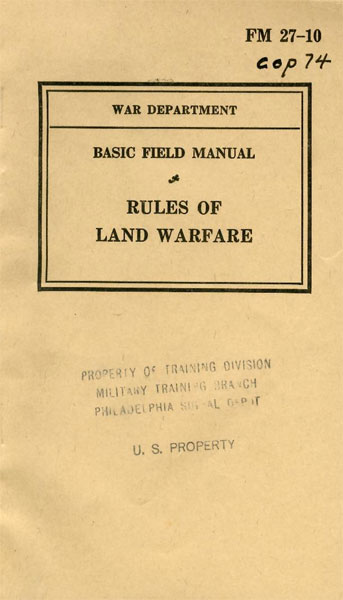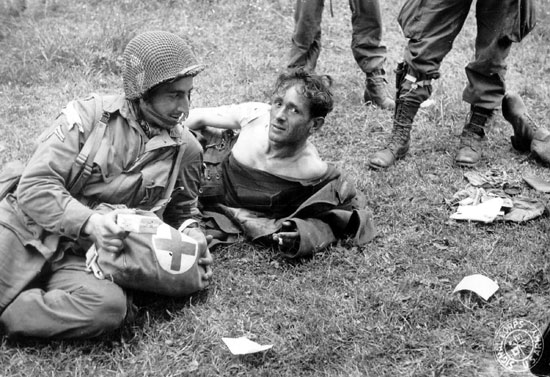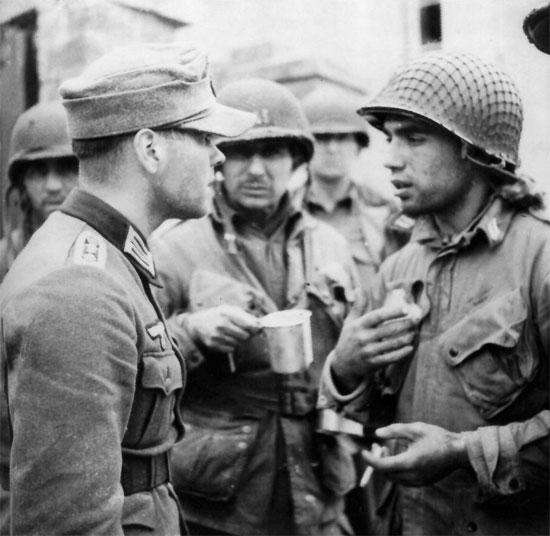WW2 Basic Rules of Land Warfare

Illustration showing FM 27-10 – Rules of Land Warfare. As can be seen this copy was issued by the Training Division, and remained its property. The Field Manual is dated October 1, 1940.
Introduction:
We have tried to interpret some of the basic Rules of Land Warfare, specifically related to :
- use of distinctive Geneva Convention emblem
- respect and treatment of captured sick, wounded, and dead
- misuse of certain Geneva Convention insignia
- belligerent medical personnel and sick and wounded interned in neutral territory
(Geneva Convention of July 27, 1929, for the Amelioration of the Condition of the Wounded and Sick of Armies in the Field, Treaty Series No. 847, between the United States and other Powers, 1923-1937, Volume IV, 5209 + Geneva Convention of July 27, 1929, relative to the Treatment of Prisoners of War, Treaty Series No. 846, between the United States and other Powers, 1923-1937, Volume 5224).
Use of Distinctive Geneva Convention Emblem:
The Red Cross (out of respect for Switzerland, reversed Swiss Federal colors, i.e. Red Cross on White field) is used as the emblem and distinctive symbol of the medical services of Armies. However, for countries already using, in place of the Red Cross, the Red Crescent, or the Red Lion and Sun on a White Field, these emblems shall likewise be recognized within the meaning of the Geneva Convention.

Medical personnel of the 101st Airborne Division attend to wounded German troops. Of interest is the use of the rigger modified Airborne pack.
The Red Cross emblem is to appear on flags and materiel of medical services, with the permission of the competent military authority. Protected personnel shall wear, attached to the left arm a brassard bearing the distinctive Geneva Convention symbol, issued and stamped by a competent military authority, it shall be furnished with proof of identity under the form of a special document. The distinctive flag of the Geneva Convention shall only be displayed over medical formations and establishments to be respected, and with the consent of the military authorities. Personnel and materiel properly identified with the Red Cross or Geneva Convention emblem shall be protected by the Convention!
Respect of Captured Sick, Wounded and Dead:
The wounded and sick of an Army who fall into the power of the other belligerent forces shall be considered Prisoners of War, and the general rules of International Law in respect to Prisoners shall be applicable to them.
When a belligerent is compelled to leave wounded or sick behind in the hands of the enemy, he shall leave with them, so far as military requirements permit, a portion of the medical personnel and materiel of his sanitary services to assist in caring for them. After every engagement, the belligerent who remains in possession of the battlefield shall take all measures to search for the wounded and the dead, and protect them from robbery and ill treatment! Mobile sanitary formations and fixed medical establishments are to be respected and protected by all belligerents. Personnel charged exclusively with removal, transportation, and treatment of the sick and wounded, as well as with the administration of sanitary formations and establishments, and the Chaplains attached to field Armies, shall be respected and protected under all circumstances. If they fall into the hands of the enemy, they shall not be treated as Prisoners of War. Any military personnel which has received special instructions to be used as auxiliary attendants or litter bearers in the removal, transportation, and treatment of the sick and wounded, and bearing the necessary identification documents, shall benefit the same regime as the permanent medical personnel, if captured by the enemy while performing these functions! Personnel from other branches employed as orderlies or armed guards for medical units, will be treated as sanitary personnel, if they carry orders showing such status, and have not during such status, acted as combatants.

A Medic of the US 1st Infantry Division tends to a wounded German soldier. This photograph is believed to have been taken in July 1944 in Normandy, France.
Prisoners who, because of wounds or sickness, would run greater risks by being evacuated than by remaining where they are, may be temporarily kept in a danger zone. If, because of his physical or mental condition, a Prisoner of War is unable to identify himself properly, he shall be turned over to the medical authorities. Expenses of medical treatment, including those of temporary prosthetic equipment, shall be borne by the detaining power. Prisoners who are affected with a serious illness or whose condition necessitates a major surgical operation, must be admitted, at the expense of the detaining power, to any military or civilian medical establishment qualified to treat them. It shall be allowed for belligerents to authorize, by means of special arrangements, the retention of physicians, hospital attendants, or other medical personnel, to care for Prisoners of their own country. Unless the conduct of military operations so requires, sick and wounded PWs shall not be transferred as long as their personal recovery might be endangered by the journey. Belligerents are bound to send back to their own country, regardless of rank or number, seriously sick and severely wounded Prisoners of War, after having brought them to a condition where they can be transported. Possibilities will cover either full repatriation or hospitalization in a neutral country. Mixed medical commissions will be set up to that effect for inspection of Prisoners designated for possible repatriation or hospitalization in a neutral country. Exchange of Prisoners (usually those held captive for long periods) can take place, number for number, rank for rank, disability for disability, with added condition for added condition, such as not to serve for a certain period of time. Belligerents shall mutually inform each other as soon as possible, of the names of the wounded, sick, and dead collected or discovered by them, as well as all indications which may serve for their identification. All wounded and sick shall be properly treated, while all dead shall be honorably buried (graves’ sites identified).
Improper Use of Distinctive Insignia of the Geneva Convention:
The use of the emblem of the Red Cross must be limited to the protection and designation of sanitary formations and the personnel and materiel which the Geneva Convention provides shall be respected. As examples of the misuse of such emblem may be cited the following:
- using a Hospital or other building accorded such protection, as an observatory or military office or store
- firing from a building or tent displaying the Red Cross emblem
- using a Hospital Train to facilitate the escape of combatants
- displaying the Geneva Convention emblem on cars or wagons containing ammunition or non-medical stores
using the Red Cross symbol for cloaking acts of hostility.
Belligerent Interned Medical Personnel and Sick and Wounded:

Belligerents discuss modalities for treating friendly and enemy casualties. Picture taken in June 1944 at the 505th Regimental Aid Station # 2 (82d Abn Div), located in Sainte-Mère-Eglise. The 505th PIR Officer to the right negotiating with the German PW is Capt Alexander “Pete” Suer (Regimental Dentist).
Medical personnel belonging to Belligerent forces, who have sought asylum in a neutral country, and are interned, can be released and permitted to return to their own country and Army.
A neutral power may authorize the passage into its territory of sick and wounded belonging to Belligerent Armies, on condition that the convoys bringing them shall carry neither personnel nor war materiel. There is no obligation to permit such passage, but when permitted, the neutral country must exercise control, and remain impartial in its treatment to all Belligerents. Sick and wounded Belligerents may carry on to their own territory, or be left in the neutral country to be interned. Sick and wounded Prisoners of War, brought into neutral territory, as part of an evacuation convoy, must be interned so as to insure that they cannot take part again in the war.
Remark:
Additional information and guidance about rules and principles can be found in FM 27-10, War Department – Basic Field Manual, “Rules of Land Warfare”, dated October 1, 1940, prepared under direction of The Judge Advocate General. This Manual supersedes Basic Field Manual, Volume VII, Part Two, of January 2, 1934.
